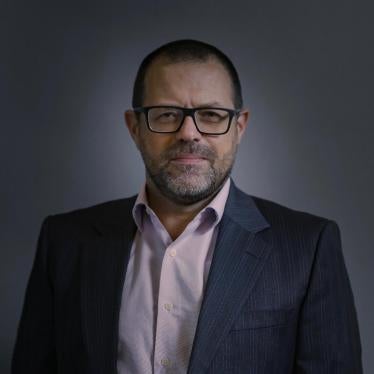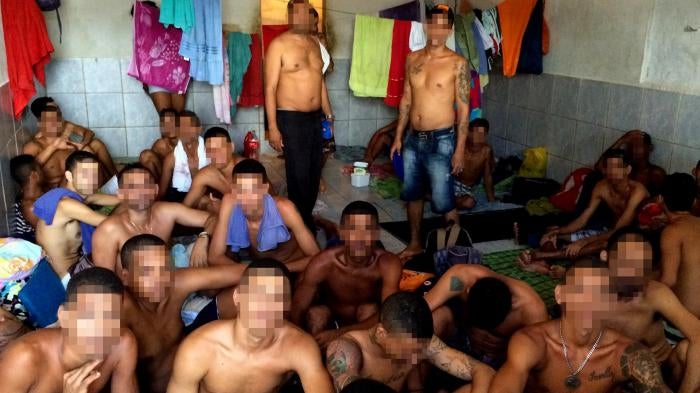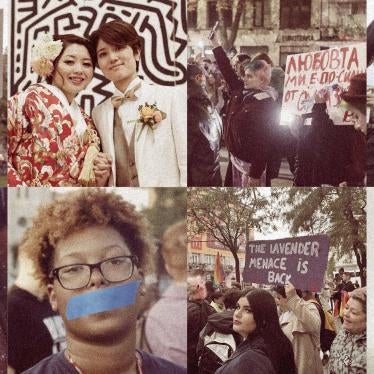Historians of medieval times would recognize much in Brazil’s modern-day prisons. Detainees are often held in dark, humid, and poorly ventilated cells. Disease is rampant; prisoners are almost 30 times [1] more likely than members of the general population to have tuberculosis. In the last three weeks, more than 130 inmates [2] died in seven states, most in mass killings. Some had simply been gutted, while others were decapitated or fully dismembered. Brazilian prison gangs use such brutality to terrorize their enemies.
In 2015, then-Justice Minister José Eduardo Cardozo [3] called the prisons “medieval dungeons.” Years earlier, he had remarked that, “from the bottom of my heart, I would rather die than be incarcerated in one of our prisons for many years.” Like Cardozo, successive Brazilian governments on both the left and the right have decried Brazil’s prison problem. But each and every one has abdicated its responsibility to provide humane detention and to guarantee the security of inmates.
A BREEDING GROUND FOR MORE CRIME
As of 2016, the Curado prison complex [4] in Recife, northeast Brazil, held about 7,000 inmates in facilities built for 1,800. The outside door leads to the “cage,” a kind of lobby through which a visitor can reach administrative areas. Guards control the cage, but once you pass through the gate into the prison’s interior, you’re on your own.
Within the outer walls, the prison is divided into pavilions—fenced-in areas with multiple cellblocks. The cellblocks are unlocked; according to a prison official, overcrowding is so severe that inmates would “suffocate” if locked inside the cells, so they are free to circulate within the pavilions and to sleep in corridors and makeshift cubicles.
Guards do not go inside pavilions. The critically short-staffed prison authorities put certain detainees in charge of the pavilions and give them the keys. Many of these “keyholders” use their power within their pavilions to sell drugs and extort payments from fellow prisoners and their families. They use other inmates to make threats against and assault prisoners who don’t pay their debts or who question the keyholders’ rule. Prison officials remain either willfully blind to the rackets or else become part of them, a prison director and former detainees said in interviews.
The keyholder system is specific only to certain prisons in Brazil, but what is common nationwide is authorities’ lack of control over what goes on inside the prisons. In the Pedrinhas prison complex in the state of Maranhão, for instance, I witnessed prison officials asking incoming detainees which gang each belonged to so that they could place the prisoners in facilities run by that gang. While there, I interviewed two young detainees who had just arrived after being arrested along with more than 30 other men at a party in a house where police found drugs and two guns. Both were married with children, had jobs, and had no prior record. They said they did not belong to any gang, but still they requested to be sent to a facility assigned to the gang that controlled their local neighborhood. Each feared death at the hands of rival gang members. This system is a recipe for gang recruitment, with consequences for the detainees—and the public—long after their release.
The reaction to the latest round of mass prison killings is revealing. “Good families,” said [5] Fernando Francischini, a federal lawmaker and former security secretary for Paraná State, “are giving a standing ovation” to the news of the killings. The governor of the state of Amazonas, José Melo, said [6] that “there was no saint [among the dead]. They were rapists, killers.” The national youth secretary, Bruno Júlio, even called for more violence [7]. “There have to be more killings,” he said. “There should be a mass killing per week.” After an avalanche of criticism, the government forced Júlio to resign.
Statements like these reflect the belief among many Brazilians that killing criminals—or in this case, letting inmates kill each other—is a good public security policy. In a recent poll, more than half of those interviewed said [8] they agreed with the Brazilian saying that “a good criminal is a dead criminal.” The implication is that an inhumane and unsafe prison system where recurrent violence leaves prisoners dead is working just fine.
That is profoundly short-sighted—not just because it ignores the rule of law and respect for human dignity but also because it is absolutely counterproductive for public security. The chaos inside the prisons has spread outside the prison walls. The two main gangs in Maranhão, for instance, were formed by detainees in the last decade to protect themselves from attacks in prison since the state was unable or unwilling to do so. Released onto the street, those gangs have now divided up São Luis, the state capital, between them. Their tags on stop signs and buildings mark the neighborhoods they control.
MASS SLAUGHTER BEHIND BARS
The recent violence in Brazil’s prisons seemed to take Brazil’s officials by surprise. Just a few weeks prior, in December, the federal government had diverted [9] funds intended for prison improvements to other uses.
Further, it took three days for President Michel Temer to talk publicly about the first massacre, on January 1, in which 56 inmates died in the Anísio Jobim prison complex in the state of Amazonas. He called [10] it a “devastating accident.” But an accident is, by definition, random and unexpected. The killings were anything but—not just because the dire state of the country’s prisons is well known but also because there were specific warnings about the explosive situation in Amazonas.
In January of 2016, the National Mechanism for the Prevention and Combatting of Torture—a body within the Justice Ministry—said [11] after a visit to Anísio Jobim and three other prisons in Amazonas that prison authorities were “neglectful” in their duties in the face of the activities by prison gangs. The representatives warned about the possibility of riots and noted that prisoners “basically self-govern within prison, and that has an impact on legal security and, more important, the right to life.”
Similarly, there was plenty of warning before the 31 killings in the Penitenciária Agrícola de Monte Cristo in Roraima on January 6. In September, the National Council of Justice said [12] conditions were “terrible” at that prison, which held more than twice as many inmates as its official capacity. A month later, ten inmates were killed there.
Overall, as of December 2014, Brazil had about 622,000 [1] men and women behind bars. Prison capacity was about 372,000. In total, at least 372 [13] inmates were killed last year nationwide, and the number does not even include those who were attacked in prison but died later in the hospital.
The raw numbers do not convey the inhumane conditions caused by the severe overcrowding. In Curado, I entered a cell containing 60 men that had only six cement bunks. Because there was not enough floor space for the men to lie down, they had put up a web of hammocks. The cell smelled overwhelmingly of feces, sweat, and mold.
REMEDIAL STEPS
Many of the people incarcerated in Brazil should not be in prison in the first place. About 42 percent [14] of those detained are awaiting trial, compared with the world average of 22 percent and an average in developed countries of eight percent, according to the Ministry of Justice. According to a 2014 study [15], 37 percent of those in pretrial detention in Brazil end up not being sentenced to prison at trial. And they are routinely housed among convicted criminals, a practice that violates both international standards and Brazilian law and facilitates gang recruitment. In 2014, the UN Working Group on Arbitrary Detention warned [16] of “a worrying trend towards using the deprivation of liberty as a measure of first rather than last resort, as would be required by international human rights standards.”
Brazil desperately needs a policy overhaul to end inhumane overcrowding. https://t.co/Hrajw0zOnF #PrisonReform #ReformaPrisional pic.twitter.com/TvOM8zutSB
— Human Rights Watch (@hrw_brasil) January 9, 2017
One measure that can prevent the excessive use of pretrial detention is to bring those who get arrested before a judge without delay so that the judge can make an informed decision about whether the suspect should await trial in jail. Such “custody hearings,” which also allow judges to examine suspects for signs of police abuse and are required by international law, only began in Brazil in 2014. Today, they are still only held in state capitals and a few other jurisdictions.
Brazil must also end excessive delays in judicial proceedings once they are underway. In October 2016, I interviewed two women in a prison in the state of Pernambuco who had been waiting more than six years for trial. I also documented cases of people who remained in prison after the end of their sentences—including a man who spent 10 additional years behind bars because of the incompetence of the judicial system. He had no lawyer or family. To prevent cases like his from falling through the cracks, a 2012 law [17]required the creation of an integrated data system that should contain information about each case from the police, prison authorities, and judges, but the system still has yet to be created. Another important measure to end delays is a requirement in a 2009 resolution [18] of the National Council of Justice for judges to review the cases of pre-trial detainees every three months. Yet judges are not complying with that requirement. The National Council of Justice needs to press for compliance. Having more public defenders to advocate for detainees would also help end the delays. Another key measure is to make wider use of alternatives to prison, such as community service, fines, house arrest, or wearing a security bracelet.
Brazil’s “war on drugs” policy is also in need of reform. More than a quarter [1] of convicted detainees are in prison on drug charges. Among women, the fraction is closer to two-thirds. And several [19] studies [20] have found that drug policies are used to punish people for holding small quantities of drugs. One of those is a young man I will call “Roberto.” He was sentenced to more than four years in prison for possessing with intent to sell 15 grams of marijuana, an amount worth 50 reais (about $15), and was held in Curado, side by side with convicted murderers, when I visited in 2015. His mother told me that other prisoners were pressuring Roberto to join their gang. Brazil should decriminalize the possession of drugs for personal use and look at ways to effectively regulate the distribution of drugs.
Brazil should also invest in prevention by overhauling its overcrowded and dysfunctional juvenile detention system. The system’s goal, according to Brazilian law, is to give children in conflict with the law a chance at rehabilitation through education and other programs. In practice, many of its facilities differ little from adult prisons. Last October, I visited units in the state of Ceará where children were locked up in damp, dark cells 24 hours a day, without any educational or recreational activities whatsoever. Brazil should expand alternatives to detention for children in conflict with the law. It also needs to invest in adequate educational, health, and psychological services for children who commit serious infractions that warrant confinement so that instead of being places of isolation and punishment, detention centers are environments that provide those children with a chance to turn their lives around.
Reform is likewise needed within the prison walls themselves. Brazil needs to hire more guards and other prison personnel and provide them with adequate training; it needs to improve the controls at the prison gates—including searching all prison personnel for contraband—and to investigate cases of violence within prisons and prosecute those responsible. Officials should also be providing inmates with opportunities for both work and education. If Brazil doesn’t act now, more mass killings are sure to follow.
Links
[1] http://www.justica.gov.br/seus-direitos/politica-penal/documentos/infopen_dez14.pdf
[2] http://www1.folha.uol.com.br/cotidiano/2017/01/1850184-apos-massacre-em-alcacuz-rio-grande-do-norte-tem-nova-rebeliao-em-natal.shtml
[3] http://brasil.estadao.com.br/noticias/geral,presidios-brasileiros-sao-masmorras-medievais--diz-ministro-da-justica,10000001226
[4] http://www.corteidh.or.cr/docs/medidas/curado_se_04_por.pdf
[5] http://www.gazetadopovo.com.br/blogs/caixa-zero/francischini-diz-que-familias-de-bem-aplaudem-de-pe-chacinas-em-presidios/
[6] http://oglobo.globo.com/brasil/nao-tinha-nenhum-santo-diz-governador-do-am-sobre-presos-mortos-20729066
[7] http://blogs.oglobo.globo.com/panorama-politico/post/sobre-chacina-secretario-de-temer-diz-que-tinha-era-que-matar-mais.html
[8] http://g1.globo.com/sao-paulo/noticia/2016/11/para-57-dos-brasileiros-bandido-bom-e-bandido-morto-diz-datafolha.html
[9] http://opiniao.estadao.com.br/noticias/geral,despir-um-santo-para-vestir-outro,10000096851
[10] http://g1.globo.com/politica/noticia/temer-afirma-que-chacina-no-presidio-de-manaus-foi-acidente-pavoroso.ghtml
[11] http://www.sdh.gov.br/sobre/participacao-social/sistema-nacional-de-prevencao-e-combate-a-tortura-snpct/mecanismo/Unidades_Prisionais_de_Manaus___AM.pdf
[12] http://g1.globo.com/rr/roraima/noticia/2017/01/inspecoes-em-presidio-apontaram-superlotacao-e-pessimas-condicoes.html
[13] http://www1.folha.uol.com.br/cotidiano/2017/01/1847165-uma-pessoa-e-assassinada-a-cada-dia-em-presidios-no-brasil.shtml
[14] http://www.justica.gov.br/noticias/em-cooperacao-com-mjc-defensoria-publica-criara-forca-tarefa-para-analisar-casos-de-presos-provisorios-no-amazonas
[15] http://brasil.estadao.com.br/noticias/geral,no-brasil-37-dos-presos-provisorios-acabam-soltos-diz-ipea,1599101
[16] http://ap.ohchr.org/documents/dpage_e.aspx?si=A/HRC/27/48/Add.3
[17] http://s.conjur.com.br/dl/lei-12714-preve-sistema-informatizado.pdf
[18] http://www.cnj.jus.br/busca-atos-adm?documento=2754
[19] http://www.teses.usp.br/teses/disponiveis/8/8132/tde-31072015-151308/pt-br.php
[20] http://redejusticacriminal.org/pt/publication/prisao-provisoria-e-lei-de-drogas-um-estudo-sobre-os-flagrantes-de-trafico-de-drogas-na-cidade-de-sao-paulo/










